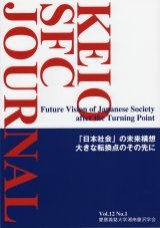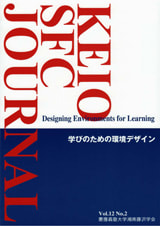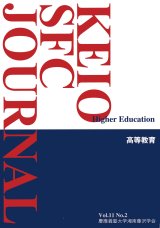- HOME
- KEIO SFC JOURNAL
- Vol.12 No.1

KEIO SFC JOURNAL Vol.12 No.1 Future Vision of Japanese Society after the Tarning Point
published on 2012.09
-
The Land and Society of Japan - their Future Images and Problems
Takashi Onishi Professor, Department of Urban Engineering, the University of Tokyo / President, Science Council of Japan We can identify major issues, which may bring about changes in the future of Japan towards 2050, as follows: energy problems, environmental problems to realize a low-carbon society and disaster reduction practices to seek constructing strong national land against natural hazards, as population reduction and growth of Asian countries go on. It becomes more important to tackle with the promotion of disaster reduction including the retreat from natural hazard areas, balanced utilization of national land without too much concentration into a particular metropolitan region, forming sustainable societies in which the use of renewable energy is maximized and the development of new frontier of the science and technology from the universe to the ocean.
-
Affecting Changes through Social Innovation - Global and Japanese Societies in the Post East Japan Earthquake/Tsunami Era
Ikuyo Kaneko Professor, Graduate School of Media and Governance, Keio University
Hideyuki Inoue Guest Associate Professor, Graduate School of Media and Governance, Keio University Has the Japanese society been changed in the post 3.11 era? The Japanese civic society was given a chance to connect with global citizens, and to accelerate changes via social innovation in various situations after the disaster. In addition to connecting with people in the global arena by telling "personal" stories and communicating with a "real voice," the Japanese approach for social innovation has shown the characteristics of the "collective impact model" rather than the "hero-entrepreneur model." This former model has a trace of traditional methods in the past and this model seems to be more authentic and suitable for social innovation in Japan.
Download this article (PDF): SFCJ12-1-02.pdf -
Japan by Environmental Design
Hikaru Kobayashi Professor, Graduate School of Media and Governance / Faculty of Environment and Information Studies, Keio University Yasushi Ikeda Professor, Graduate School of Media and Governance / Faculty of Environment and Information Studies, Keio University This paper looks to the direction Japan needs to take into the future in light of the multiple disasters that struck northeast Japan in March, 2011, including the earthquakes, tsunamis, and the massive radioactive contamination from Fukushima nuclear power plant. It also considers the national economy in the context of the Kyoto protocol. In terms of investment in environmental issues Japan was surpassed in the 1990's by several EU nations, in part because of its economic decline. However as a result of the crisis caused by the 2011 disaster domestic demands are changing and the potential to develop a new socio-economic system with environmental issues at its center has become more realistic. As part of that process this paper proposes a larger investment by industry along with more effective utilization of environmental resources, social innovation and lifestyle changes, new architecture and urban planning that make use of advanced information communication technology, and targeted education aimed at training environmental leadership, as with the Environmental Innovators program at Keio University's Graduate School of Media and Governance. Chapters 1 to 8 are mainly written by Hikaru Kobayashi, while chapters 8 and 9 are mainly written by Yasushi Ikeda.
Download this article (PDF): SFCJ12-1-03.pdf -
Scanning the Earth - Radiation Measurement Activities in the Fukushima Area
Keisuke Uehara Associate Professor, Faculty of Environment and Information Studies, Keio University Tomoyuki Furutani Associate Professor, Faculty of Policy Management, Keio University Radiation specialists, researchers and citizens' groups measure radiation following the accident at TEPCO's Fukusima-Daiichi nuclear power plant. The methodologies of measurements are completely different from those used after earlier accidents. Now the Internet can be used to share data, Bayes estimation is now mature for analysis and GIS can be used to map the result. This paper describes a sensor network we developed, measurement methodologies using All Terrain Vehicle (ATV) and Unmanned Aerial Vehicle (UAV), and our analysis method with Bayes estimation and mapping using GIS.
-
Development of the East China Sea Gas Field Dispute - Explaining Domestic Opinion Constraints on Chinese Foreign Policy
Vida Macikenaite Doctoral Program, Graduate School of Media and Governance, Keio University This paper attempted to explain how domestic opinion had shaped China's policies toward the East China Sea gas field dispute with Japan. It suggested an enhanced conceptual explanation of domestic opinion in China distinguishing between general domestic opinion and limited voiced opinions. Through such theoretical clarification it was possible to explain the inconsistency of Chinese policies. The research found that gas field dispute policy was a result of the policy makers' consideration of domestic opinion rather than their direct response to the voiced opinions. Chinese policy makers adopted preemptive rather than reactive policies and it delayed their decisions.
Download this article (PDF): SFCJ12-1-05.pdf -
A Bureaucrat's Anticipated Reaction to the Divided Diet - Case Study on a Bill Lobbying by the Japan Patent Office
Junsuke Matsuura Doctoral Program, Graduate School of Media and Governance, Keio University / Part-time Lecturer, Faculty of Humanities, Toyo Gakuen University This paper analyses the legislative process of the bill on partial revision of the design act, etc. and the bill on partial revision of the patent act, etc., for the purpose of describing the bureaucrat's anticipated reaction to the divided Diet in 2007-2009. Although both bills passed Diet smoothly, this empirical analysis showed that the bill lobbying by the Japan Patent Office had changed a lot after the opposition party gained a majority of the House of Councillors as a result of the Upper House election in 2007.
Download this article (PDF): SFCJ12-1-06.pdf -
Word Sense Disambiguation Using a Contextual Semantic Network
Jun Okamoto Assistant Professor, Department of Business Innovation, Kaetsu University/Senior Visiting Researcher, Keio Research Institute at SFC Shun Ishizaki Professor, Faculty of Environment and Information Studies, Keio University We proposed a method of word sense disambiguation using Contextual Semantic Network (CSN). This network is constructed using concept dictionaries (Associative Concept Dictionary and WordNet) which include semantic relations among concepts. In the network, an interactive activation method is used to identify meanings of a homographic ideogram on the CSN where the activation values on the network are calculated using the distance information between concepts. Dynamic Contextual Network Model is applied to the network, where the network structure changes according to the successive input words in the sentences. The model enhances the network dynamically by adding words from the input sentence until the model obtains a certain threshold to decide the appropriate meaning of the homographic ideograms.
Download this article (PDF): SFCJ12-1-07.pdf
-
Introduction to Writing Science and Technology Documents Authored by Toru Koyama, Keio University Press, April 2011
Reviewed by Yoshiyasu Takefuji Professor, Faculty of Environment and Information Studies, Keio University

